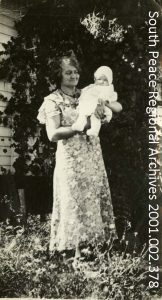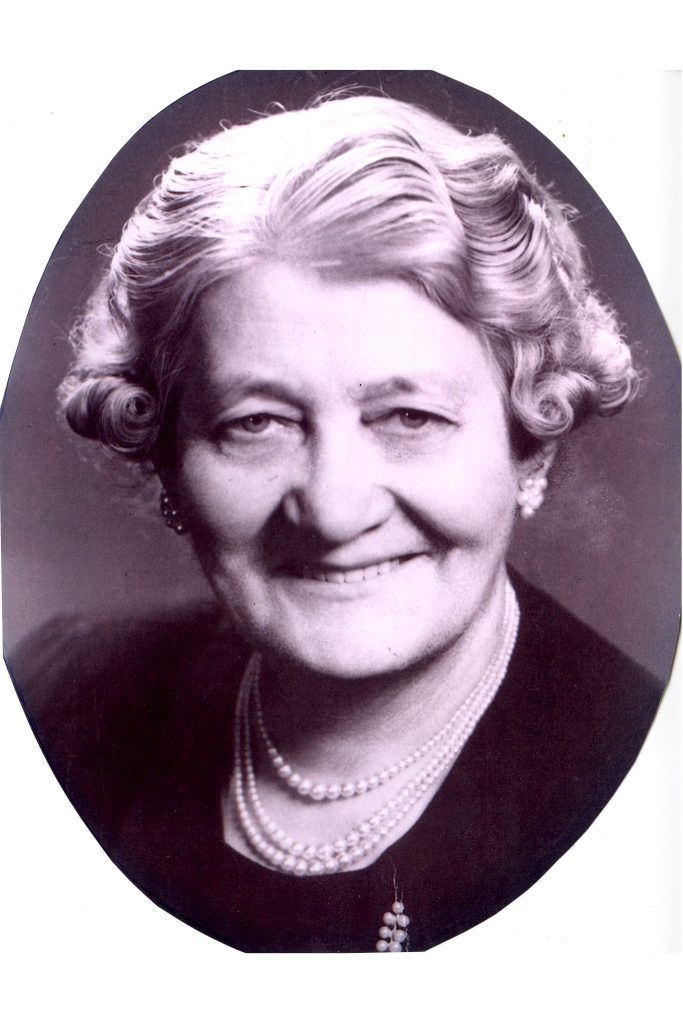Image: “Aunt Jo” Haakstad, 1956. (SPRA 2009.122.03)
The name “Johanna Haakstad” often elicits smiles and nods. For many of Johanna’s “grandbabies,” this kind woman not only presided over the birth of their parents, she also documented the first part of their lives.
“Aunt Jo,” as she was often called, was born in Norway in 1885 and immigrated to Minnesota with her family in 1888. Along with her daughter Thelma and other family members, she immigrated to Canada in 1906. Johanna worked a number of jobs but midwifery was her calling. She carried out her training with Dr. McPherson and, for over 15 years, assisted local doctors or practiced on her own at home births. Johanna usually remained with her patients for several days to run the home while the mother rested.
In 1928, Johanna rented a shack in Sexsmith, which became the first Maternity Hospital. The Hospital moved to several locations but the care Johanna showed her patients never wavered. It grew from a small three room shack in 1928 to a six-bed hospital in the 1940s. The Hospital was known variously as Sexsmith Maternity Home; Stork Hospital; and Johanna Haakstad Maternity Home. Over the years, it received support from local community organizations such as the Anglican Women’s Association and the Sexsmith Women’s Institute. In the course of her thirty year career, Johanna “Aunt Jo” Haakstad delivered 3,100 babies in the South Peace region. At her retirement in 1958, the Maternity Home was also retired. Johanna died in 1963, at the age of 78.
Despite the importance of the Maternity Home, the Archives has only scattered records about Johanna and the Home. Most of what we know comes from our reference file collection and a lengthy story in the community history book, Wagon Trails Grown Over. Johanna and the maternity home are mentioned in several pioneer stories, including the Bentrer, Haukedal, and Sandboe families in La Glace, but often only to note that babies were born under her care.
There are a few photographs of Johanna posing with “her” babies in SPRA 001 Pioneer Museum of Grande Prairie & District fonds, but she left little of herself for us to discover. It may not be surprising, though, to learn that this giving woman took great care in documenting the women and children she nurtured.
The Johanna Haakstad Maternity Home fonds contains several loose notebook pages. In her article for the 24 October 1985 Western People magazine, Gertrude Bryan wrote, “Johanna’s simple record book lay on the little table inside the door—an exercise book with a heavy black cover. Date of entry, name of mother, and sex of child, date of discharge and, then, ‘Both Well.’ Dear Jo.” This little record book records all the births at the maternity home up to 1949, though it has since lost its black cover.
Despite its homespun appearance, the notebook is a medical record. As a result, the Archives is responsible for managing restrictions on access. The personal information contained in any kind of medical record, even the plain black scribbler Johanna used to record her patients’ information, is governed by the Alberta Freedom of Information and Protection of Privacy Act (FOIP). Part 3 of the FOIP Act, “Disclosure of Information in Archives,” states that archives of a public body— such as the South Peace Regional Archives— may only disclose personal information if it has been in existence for 25 years or more and if the disclosure would not be an “unreasonable invasion” of a third party’s personal privacy. The release of medical information is considered an unreasonable invasion of personal privacy.
Of course, it’s not just medical records that have restrictions; school records do as well. A former straight-A student may not mind having their records perused 10 years down the road but a D student probably would. They may experience embarrassment over attendance or health issues recorded in school records, such as visits to a school counselor.
These regulations do not necessarily mean the records are unavailable. It does mean that the Archives needs to practice special care in how we make them available. When a record is part of a form that includes multiple names, we may not provide the original physical copy for viewing. We would locate an individual’s information and copy or transcribe it in a way that protects everyone else.
Based on Gertrude’s account, Johanna’s book may well have been in view for all to see. In a small community, it would have been difficult to maintain a high level of privacy for something as noticeable as a new baby or mother returning home childless. But that kind of community engagement did not envision the rapid dissemination of information on the internet. Word of mouth has some limits: the internet, less so. Johanna cared very much for the patients in her care. We extend that care by respecting the privacy of their personal and perhaps painful moments.
This article was originally featured in the December 2019 issue of Telling Our Stories.

